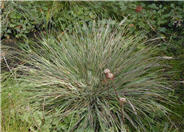
Common name:California Gray Rush
Botanical name:Juncus patens
Although a wetland plant, Juncus patens can tolerate fairly dry conditions. Eventually will clump to 2'-3' in many years. Grows to a height of 2'-2.5'. There are many selections of this species available with different foliage variations and heights. Carefree with little to no maintenance. Provides great upright structure to many styles of landscapes.

Common name:Blue Moor Grass
Botanical name:Sesleria caerulea
This grass will grow to about 18-24"H x 18-24"W. It has blue/green or gray/green leaves.

Common name:Elijah Blue Fescue
Botanical name:Festuca 'Elijah Blue'
The 'Elijah Blue' is a dwarf, very glaucous variety with almost white foliage. It should receive sun and little summer watering. -Monterey Bay Nursrey

Common name:California Fescue
Botanical name:Festuca californica
The California fescue is a cool season bunchgrass with blue-green blades that reach 2 ft. high. The flower stalks are 5 ft. tall and create fountain-like clumps. This grass is drought tolerant for sun and shade. The California fescue is native to California and is a beneficial insect plant. -Cornflower Farms

Common name:Manzanita Emerald Carpet
Botanical name:Arctostaphylos 'Emerald Carpet'
The 'Emerald Carpet' is an evergreen groundcover that grows to 1' tall by 6-8' wide. It is favored by many landscapers as the manzanita of choice for inland situations. It has dark green leaves and exhibits compact growth. This variety is relatively tolerant of adverse soil conditions. -Monterey Bay Nursery

Common name:Western Redbud
Botanical name:Cercis occidentalis
This deciduous shrub ranges from 6-20 ft. tall and 10-15 ft. wide. It is desirable for its magenta spring flowers, yellow to red fall color, and dangling winter seed pods. It is tolerant of many soil types, drought and oak root fungus. It attracts hummingbirds and butterflies. The Western Redbud can be found statewide in California in the foothills below 4500 ft. elevations in chaparral and woodland communities
- Cornflower Farms

Common name:Winifred Gillman Blue Sage
Botanical name:Salvia clevelandii 'Winnifred Gillman'
The ' Winnifred Gilman' sage is a dense, compact sub-shrub that grows to 4-5 feet tall and wide, and has a round form. It has blue flowers in spikes above the foliage in the spring and summer. This sub-shrub is native to California and is drought tolerant. -Cornflower Farms

Common name:Southern Pink Flowering Currant
Botanical name:Ribes sanguineum glutinosum
The pink flowering currant is an erect,spreading, deciduous shrub that grows 4-6 ft. tall. It has lobed toothed foliage, pink flowers, and black berries between January and March. The pink flowering currant needs shade inland, and is a native to California. It is drought tolerant and attracts hummingbirds.
-Cornflower Farms

Common name:California Buckeye
Botanical name:Aesculus californica
The Aesculus californica is a tree with a year-round interest. Creamy pink or white flowers bloom in the spring, and when late summer arrives, these leaves drop to unveil pear-shaped fruits.

Common name:Strawberry Madrone, Marina Strawber
Botanical name:Arbutus 'Marina'
The 'Marina' has gorgeous bark, with leaves that are smaller and not as glossy as Pacific Madrone. Its flowers are pink, borne in pendant clusters in the summer. The fruit is large, red and quite ornamental. The plant should be grown in sun to part shade, with little or no summer watering when established. The 'Marina' prefers good drainage. -Monterey Bay Nursery

Common name:Reed Grass
Botanical name:Calamagrostis foliosa
This tufted perennial bunchgrass is native to the northern California coastal scrub. It forms a beautiful, dense mound of grey greeen leaves that reach 2' tall, with showy arching flower stalks to 3' tall. Reed Grass leaves assume an attractive purple coloration in the fall and winter. This evergreen should be grown under sun, with little or no summer watering required. -Monterey Bay Nursery
| Designer: Liz Ryan | Raucous but Fun |
Photographer: GardenSoft |
Soils and Compost:
Physical weed control, including mulching, or hand removal protects the watershed from harmful chemicals.
Water Saving Tip:
Check soil moisture below the surface with a soil probe or large screwdriver, trowel or shovel. Don't assume the plants need water just because the soil surface looks dry.
Integrated Pest Management:
Drip and other smart irrigation delivers water directly to roots, allowing no excess water for weeds.

